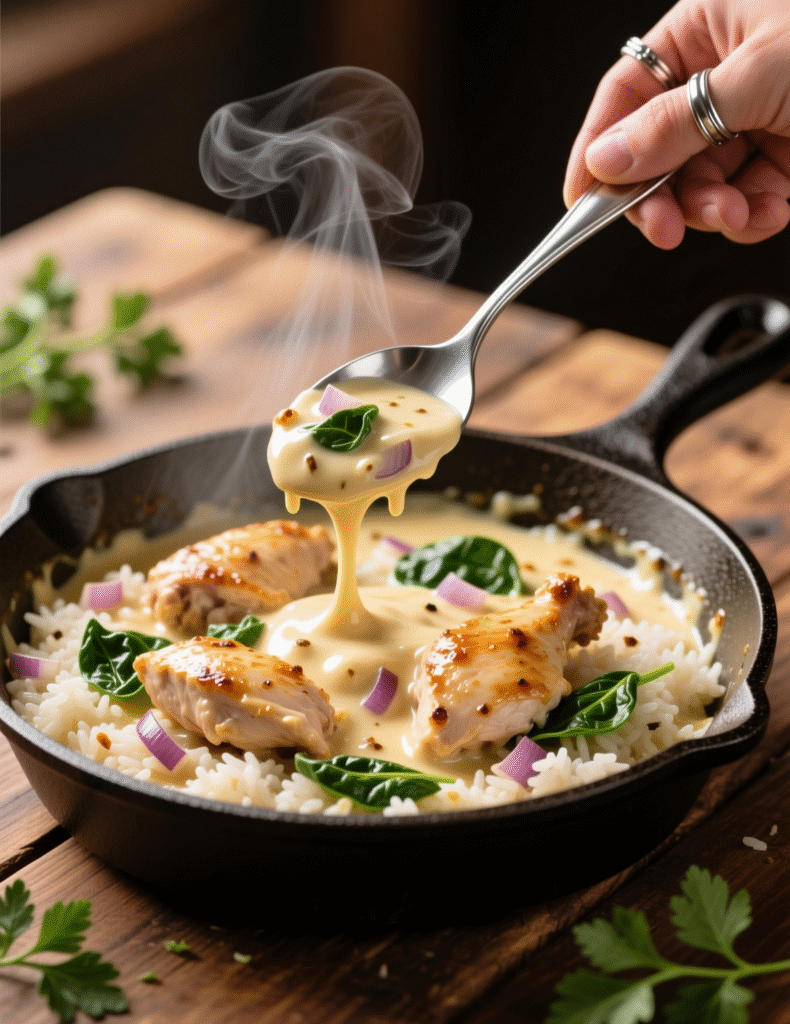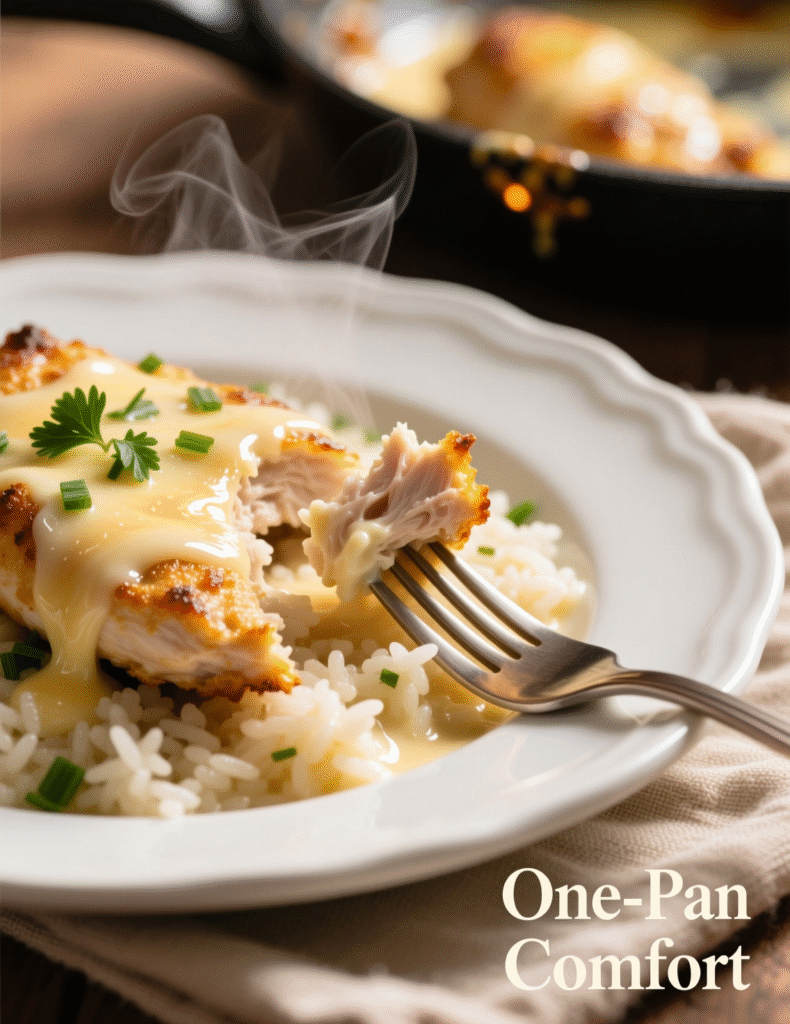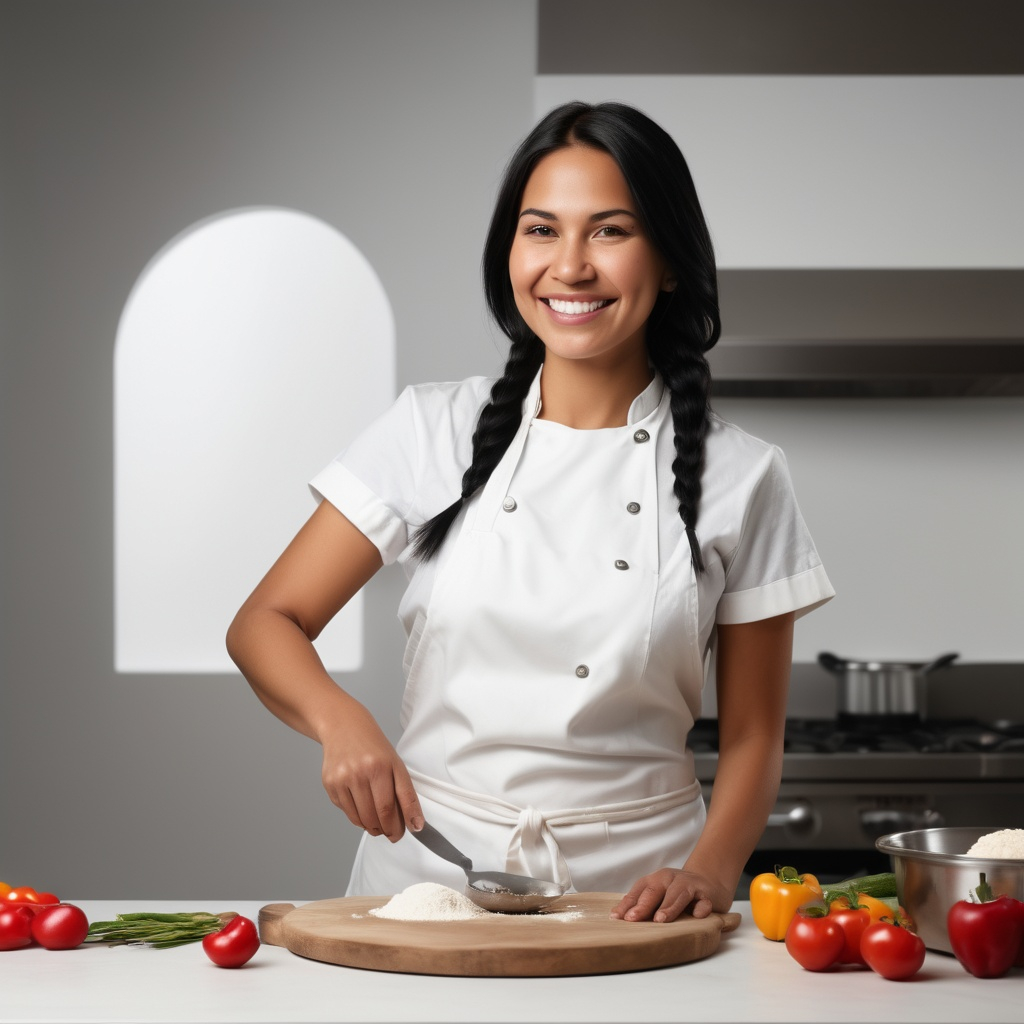There’s something oddly satisfying about cooking everything in one pan. The sizzling sound when chicken meets hot oil, the slow simmer as rice soaks up creamy sauce—this dish, the One-Pan Creamy Parmesan Chicken & Rice, captures that comfort and efficiency in one go. It’s rich, indulgent, and wonderfully simple. For professional chefs or skilled home cooks, it’s a recipe that balances technique, timing, and pure flavor chemistry.
The Beauty of One-Pan Cooking
In professional kitchens, efficiency is currency. Every pan washed, every extra utensil used, adds up to lost time. That’s why one-pan recipes aren’t just convenient—they’re strategic. They reduce cleanup, minimize flavor loss, and encourage ingredient harmony.
When you cook chicken and rice together, the starches from the rice thicken the sauce naturally, while the chicken juices infuse the grains with umami depth. The trick, however, lies in temperature control and ingredient layering. You can’t just dump it all in and hope for magic—it’s more like orchestrating a small, edible symphony.
Ingredients That Build Flavor
For four servings, here’s what you’ll need—but more importantly, here’s why you’ll need them:
- 4 boneless, skinless chicken breasts – Choose medium thickness for even cooking. Thin ones dry too quick; thick ones throw off the timing.
- 1 tablespoon olive oil + 1 tablespoon butter – The oil raises smoke point; the butter adds that nutty, caramel tone.
- 1 small onion, finely chopped – Sweetness and depth come from this base.
- 3 cloves garlic, minced – Adds warmth and that unmistakable kitchen aroma everyone loves.
- 1 cup long-grain white rice – Long-grain keeps its shape; short-grain can turn mushy here.
- 2 ½ cups low-sodium chicken broth – Use homemade if you can; it makes a world of diff.
- 1 cup heavy cream – The cornerstone of creaminess. Don’t swap for milk—it’ll split under heat.
- ¾ cup freshly grated Parmesan cheese – Freshly grated melts smoother; pre-grated often clumps.
- 1 teaspoon Italian seasoning – Balance of oregano, thyme, and basil.
- Salt and cracked black pepper, to taste – Always season in layers, not all at once.
- Fresh parsley, chopped (optional) – For brightness and color contrast.
Every ingredient is there for chemistry, not decoration. Rice absorbs liquid in specific ratios; cream stabilizes when paired with starch and fat. Parmesan, with its glutamate-rich profile, deepens savory notes, creating that creamy-tangy harmony chefs crave.

Preparing the Chicken: Building the First Layer
Start with the chicken. Pat it dry—seriously, don’t skip this. Moisture is the enemy of browning. Season both sides with salt, pepper, and a pinch of Italian seasoning.
Heat oil and butter over medium-high in a large, heavy skillet (preferably cast iron or stainless steel). Once the butter foams, add chicken. Sear 4–5 minutes per side until golden and slightly crisp on edges. You’re not cooking it through yet—just developing the Maillard reaction. That crust carries the entire flavor foundation.
Remove the chicken and set aside. The pan will now hold golden bits stuck to the bottom—called fond. Don’t you dare wipe it. That’s where the soul of this dish lives.
Building the Flavor Base
Lower the heat slightly. Toss in your onions. Let them sweat, not brown, about 2 minutes. Add garlic, stirring just until fragrant—no longer than 30 seconds, or it’ll turn bitter.
Pour in the rice. Yes, uncooked rice right into the pan. Toast it gently in the fat for a minute or two. This step, often skipped, is key—it coats the grains, locking in structure, preventing them from turning mushy later.
Deglaze with a splash of chicken broth, scraping up every bit of fond. You’ll see the color deepen instantly. That’s flavor reclaiming its place.
Combining the Elements
Add the rest of the broth, cream, and Italian seasoning. Stir slowly. Bring to a gentle simmer. Slide the seared chicken back into the pan, nestling each piece slightly into the rice. Don’t submerge them fully—halfway is perfect. Cover and reduce heat to low.
Simmer for 20–25 minutes. Don’t rush it. The rice needs time to absorb the liquid, the chicken to finish cooking through. Occasionally, tilt the lid to let steam escape and prevent the sauce from bubbling over.
When done right, you’ll notice the sauce thicken naturally—no cornstarch or roux needed. The rice releases starch just enough to bind with cream and Parmesan later.
The Parmesan Moment
Once the rice is tender and the chicken cooked through (165°F internal temp if you’re checking), remove the lid. Stir in the Parmesan cheese gradually, folding it through the sauce. It’ll melt, thickening it even more, turning the dish from creamy to luxuriously velvety.
Taste, then adjust salt and pepper. Parmesan adds saltiness, so don’t season blindly. Finish with a sprinkle of chopped parsley. The green not only adds visual pop—it cuts through the richness too.
The Science Behind the Creaminess
Cream-based sauces can be tricky. Too high heat, and they break. Too low, and they won’t thicken properly. The secret here is emulsification—the balance of fat (from cream and butter), water (from broth), and protein (from Parmesan and chicken).
The rice starch acts as a natural stabilizer. It keeps the sauce bound together, even when reheated later. That’s why this recipe, unlike most creamy dishes, holds beautifully the next day without separating.
Variations & Chef Tips
Professionals love flexibility. So here’s how you can adapt:
- Add vegetables: Spinach, mushrooms, or peas work great. Add them in the last 10 minutes so they don’t overcook.
- Go spicy: A pinch of red chili flakes or smoked paprika can balance the cream.
- Different cheeses: Try Pecorino Romano for a sharper edge or Asiago for depth.
- Rice alternatives: Basmati gives a lighter result; Arborio makes it risotto-like—more indulgent.
Always think balance. If adding salty cheese, reduce salt elsewhere. If using a lighter cream, simmer uncovered a bit longer to reduce excess liquid.
The Technique That Sets Professionals Apart
Here’s where many go wrong: stirring too often. Rice doesn’t like disturbance once it’s simmering. Stirring releases too much starch, turning the texture gluey. Let it cook mostly untouched, checking only midway.
Also, don’t overcrowd the chicken pieces when searing. It drops the pan’s temperature, preventing that golden crust. Do it in batches if needed. Small details like these separate good from restaurant-quality results.

Pairing & Presentation
This dish pairs like a dream with crisp greens or roasted vegetables. Think lightly dressed arugula salad or roasted asparagus with lemon. For wine, a chilled Pinot Grigio or Chardonnay balances the richness.
When plating, use shallow bowls to showcase the creamy rice beneath the chicken. Sprinkle extra Parmesan on top, let it melt slightly from the dish’s residual heat—it’s a subtle touch, but chefs know it makes a difference visually and texturally.
Common Mistakes (And How to Dodge Them)
- Sauce too thin: Simmer uncovered for 3–5 extra minutes; rice starch will do its magic.
- Chicken dry: Over-searing or overcooking. Always rest it a few minutes after cooking.
- Cream split: Heat too high. Keep it low once cream’s in the mix.
- Rice uneven: Stirring early or using wrong grain type. Stick with long-grain.
Even pros make these sometimes. It’s not failure, just fine-tuning.
The Secret Ingredient—Patience
Cooking this dish is like coaxing flavor rather than forcing it. The process demands a bit of patience and attention, but the payoff is golden. The aroma alone will tell you when it’s right—rich, buttery, with that faint nuttiness from Parmesan.
As a chef, I’ve cooked hundreds of variations of creamy chicken and rice, but this one-pan version always finds its way back into my kitchen. It’s rustic yet refined, comforting yet elevated. It’s what you make when you want to remind yourself that good food doesn’t need to be complicated—it just needs to be done right.
Nutrition Insight
Each serving roughly delivers around 580–650 calories depending on cream and cheese quality. It offers a balance of protein, carbs, and fats—ideal for post-workout recovery or hearty family dinners. Pairing it with fiber-rich greens rounds it into a full meal.
The calcium and protein from Parmesan and chicken support muscle and bone health, while rice provides sustained energy. It’s indulgent, yes, but not reckless.
Why This Recipe Works Every Time
Precision in timing, control of heat, and ingredient order—that’s what makes this recipe foolproof. The dish builds flavor in layers rather than all at once. The fond, the toasting, the slow simmer—all of these create complexity without extra effort.
It’s that type of dish that tastes like it took all day, but didn’t. And that’s where culinary mastery meets practicality.
Whether you’re running a busy kitchen or cooking at home after a long day, this recipe respects your time without compromising the result.
Final Thoughts
The One-Pan Creamy Parmesan Chicken & Rice isn’t just another comfort dish—it’s a masterclass in controlled cooking. It teaches restraint, timing, and respect for ingredients. Each step, each simmer, adds to the symphony of flavors that finish on the plate.
It’s food that feels expensive but isn’t. Food that looks effortless but carries the technique of a professional hand. And most importantly—it’s food that brings people together around the table, quietly reminding us why we cook in the first place.
Sometimes, perfection doesn’t need ten ingredients or five pans. Sometimes, all it takes is one pan, a bit of care, and a handful of Parmesan melting into rice that’s been kissed by cream. That’s where culinary poetry truly begins.
FAQs
What makes this One-Pan Creamy Parmesan Chicken & Rice recipe special?
It combines rich creaminess, balanced flavors, and efficient one-pan cooking for restaurant-quality results at home.
Can I use brown rice instead of white rice?
Yes, but it needs longer cooking time and slightly more broth for proper tenderness.
How can I prevent the cream from curdling?
Keep the heat low once cream is added and avoid boiling vigorously.
Can I use milk instead of heavy cream?
Not recommended—milk may split and won’t create the same creamy texture.
What’s the best cheese substitute for Parmesan?
Pecorino Romano or Asiago cheese offers a similar sharp, savory profile.
How do I make this dish more nutritious?
Add vegetables like spinach, mushrooms, or peas in the last 10 minutes of cooking.
Can this dish be meal-prepped?
Yes, it reheats well without losing creaminess—store in airtight containers for up to 3 days.
What type of pan works best for this recipe?
A large stainless steel or cast-iron skillet provides even heat and prevents sticking.
Why toast the rice before adding liquid?
Toasting rice enhances flavor and helps it maintain structure during simmering.
What wine pairs best with this dish?
A crisp Chardonnay or Pinot Grigio perfectly complements the creamy richness.

Marie Smith is a passionate recipe blogger, sharing easy, delicious, and creative culinary ideas that inspire home cooks to elevate everyday meals with flavor and simplicity.
